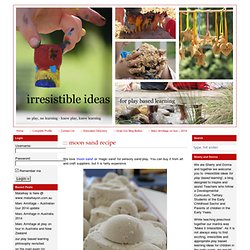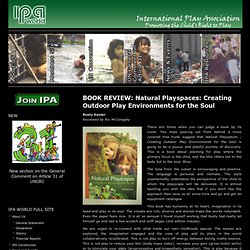

Center on the Developing Child - Harvard University. The Longfellow Lecture. Friday, March 13, 2009 Nature-Deficit Disorder: The Movement to Connect Our Children, Ourselves, and Future Generations to the Natural World by Richard Louv Richard Louv is an author and journalist focused on nature, family and community. His most recent book, Last Child in the Woods: Saving Our Children from Nature-Deficit Disorder, has stimulated an international conversation about the future relationship between children and nature.
He serves as chairman of the Children & Nature Network, an organization helping to build the international movement to connect children with nature. He also serves as honorary co-chair of The National Forum on Children and Nature. Rich has written for The New York Times, The Washington Post and other publications. The Longfellow Lecture series, inaugurated in 1987, honors the memory of Cynthia Longfellow, '72, Harvard Ed.D. '79, who devoted her professional life to bettering the lives of young children. Rethinking Childhood. No Fear. Kindling: Green makes school. So the cliche goes, there are lots of things Germany does well; public transport, sausages, compound nouns... actually all these things are true, but I've been discovering that in Berlin and Hamburg there are some other things that are done well; challenging, exciting and sustainable play provision for children and young people.

I recently spent a week in Hamburg and Berlin with a study tour for play professionals co-ordinated by ip-dip.com and www.meynellgames.org. The tour took us to scrapstores, adventure playgrounds, public parks and playspaces, community provision, waldkindergarten and green school playgrounds. On Thursday we spent the day looking at school play ares in Berlin in the company of Manfred from Grün macht Schule; www.gruen-macht-schule.de. Manfred described some of the changes. "Before this was a playground only for boys, now less aggressive; groups have spaces and it is more quiet. " Moon sand recipe. We love ‘moon sand’ or ‘magic sand’ for sensory sand play.

You can buy it from art and craft suppliers, but it is fairly expensive. When we did a post on it a while ago, some kind people sent in the recipe so we could make it ourselves at a fraction of the cost. Mix together: 4 cups sand 2 cups cornflour 1 cup of water. We gave it a go and although different from the commercial sort … it was still very successful. The children had a lot of fun with it. When it dried out in the sun a bit, it crumbled up beautifully and was easily restored with a bit more water added to it. Tags: cornflour, sand, water. Earthplay. IPA World Website » BOOK REVIEW: Natural Playspaces: Creating Outdoor Play Environments for the Soul. Rusty KeelerReviewed by Ric McConaghy There are times when you can judge a book by its cover.

Two imps peering out from behind a moss covered tree trunk suggest that Natural Playspaces ; Creating Outdoor Play Environments for the Soul is going to be a joyous and playful journey of discovery. This is a book about planning for play where the primary focus is the child, and the title refers not to the body but to the soul. Bliss. The tone from the outset is encouraging and positive. This book has humanity at its heart, imagination in its head and play in its soul. We are urged to re-connect with what made our own childhoods special. The case studies take you through the journeys of others and the challenges they faced.
There are simple projects at the back that can be undertaken by groups to bring special elements to any space. At times the text can take tangents, but this is the rhythm of Rusty, and this book is clearly his. Like this: Like Loading... IPA World Website » Play Resources. IPA Right to Play Awards – DEADLINE 15 April 2014 The “Article 31 Recognition Program” was created to recognise and celebrate projects that utilise innovative and practical ways to implement Article 31 of the UN Convention on the Rights of the Child.

Appropriate projects include activity programs, public awareness campaigns, media products, implemented national or local legislation, design of spaces, and design of play items. This award was launched at the IPA World Conference in Melbourne, Australia in 1993 and since then awards have been made at every Triennial World Conference. The awards provide an opportunity for winners and nominees to showcase their work to both their community and the world. Nominations are invited from organsations and individuals that represent profit or not for profit organisations. Download submission forms here: IPA RIght to Play Award – Project submission form (PDF form) or IPA Right to Play Award – Word submission form (MS Word) NEW!
IPA World Website » BOOK REVIEW: The Playful Brain. Sergio M.

Pellis and Vivien C. PellisReviewed by Janet Jamieson The Playful Brain, by play researchers Sergio and Vivian Pellis of the Canadian Centre for Behavioural Neuroscience at the University of Lethbridge (Alberta, Canada) is an erudite exploration of the science and mystery of play. The book is targeted to a general audience – but an educated one – with a strong interest in the adaptive nature of play in human and non-human animals. IPA Working Paper on the Children’s Right to Play (Dec2010f) Irresistible Ideas for play based learning. Sweden - Early Years.